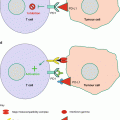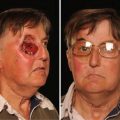Fig. 1.1
‘About Face I’ survey responses to question, “Are you familiar with the term head and neck cancer?”
Although the majority of respondents recognised that HNC affects the pharynx and larynx, other sites were poorly recognised and a number of sites were wrongly identified (Fig. 1.2). Swedish respondents were more likely to identify body parts affected by HNC correctly, whereas Italian respondents were the least likely.
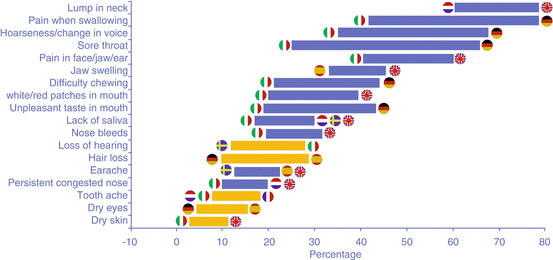

Fig. 1.2
‘About Face I’ survey responses to question, “Which of the following do you think are symptoms of HNC?”
Interestingly, although knowledge of the body parts affected by HNC was unsurprisingly higher among those respondents working in the medical profession, 57 % of this group of respondents still indicated incorrectly that the brain is categorised within HNC. This is important as the treatment regimens are different for HNC and brain tumours.
Symptom Recognition Was Highly Varied
Recognition of symptoms was highly varied based on the symptom and the country. The majority of symptoms were identified by only less than half of respondents, and many incorrectly thought that symptoms occurring in the head and neck region (e.g. hair loss, tooth ache) were indicative of the disease. Respondents from Italy and Spain had a lower level of knowledge of the symptoms of HNC than other countries, namely the UK and Germany (Fig. 1.2).
Low Awareness of Risk Factors Beyond Smoking and Alcohol
There was general consensus across all countries that lifestyle factors may increase the risk of developing HNC. Although the majority of the respondents recognised the link between HNC and smoking or high alcohol intake – a common risk factor for many cancers – far fewer were aware of the role of excessive sun exposure, human papillomavirus (HPV) infection or gender in disease aetiology (Fig. 1.3).
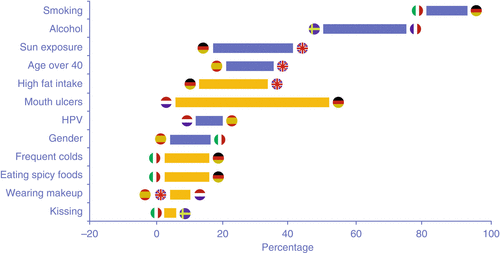

Fig. 1.3
‘About Face I’ survey responses to question, “Which of the following do you think might be risk factors for developing HNC?”
Excluding consideration of lifestyle-related risk factors that can lead to HNC, awareness that the disease can occur spontaneously was generally less than 50 % across the countries surveyed. It was noted that there was less than 10 % awareness that sexual habits, including a higher number of orogenital partners may increase the risk of HNC, and only 20 % of respondents knew of the link between HPV and HNC.
‘About Face II’
The second study in the ‘About Face’ series focused on gaining an understanding of the profiles and emotional needs of patients living with HNC in order to inform future programmes for patients.
A total of 104 patients with HNC participated in face-to-face interviews across six countries: France, Sweden, Spain, Italy, Portugal and Belgium. The survey population was representative of the gender and age distribution of the disease, and the majority of respondents were males aged 50–70 years. Questions focused on the patient journey and recall of experiences at pre-diagnosis, diagnosis, treatment and post-treatment. Respondents were asked to consider the impact of the disease (rational vs emotional) and their quality of life [2].
Results
The ‘About Face II’ study revealed that patients want better communication and understanding of the disease and process at every stage of the journey. The survey uncovered unmet needs at key junctures of the patient journey from pre-diagnosis, at diagnosis, at treatment and post-treatment.
The ‘About Face II’ survey made it clear that more education and information are needed for not only the public, but also for healthcare professionals, in order to ensure appropriate detection and management of the disease.
It was revealed that patients who have been diagnosed with HNC also need additional education and information to help deal with the realities of their condition. HNC is a debilitating and cosmetically recognisable disease and can negatively affect self-esteem and image. As a result, patients reported that they experienced a wide range of emotions with the disease throughout their journey, especially after treatment; at times, they experienced a plethora of negative feelings. These negative feelings need to be addressed.
Pre-diagnosis Stage
During the pre-diagnosis stage, patients were positive about their health and felt that their health concerns were not at the forefront of their minds. There was a general feeling that life was ‘wonderful’ before diagnosis, as well as a lack of knowledge or awareness about the signs and symptoms relating to HNC. These types of feelings and lack of awareness can lead to delayed diagnosis.
Diagnosis Stage
The diagnosis stage brought with it a wider range of emotions – from denial, anger, fear and even mental ‘paralysis’. There was a strong fear associated with death as a result of the disease and a lack of understanding of treatment options. Generally speaking, the reaction of patients at diagnosis mirrored what their response to grief would be (Fig. 1.4).


Fig. 1.4
Patients’ reactions to diagnosis mirror the response to grief
During diagnosis, patients expect a certain level of support, education and information from their physician, family and friends. In many cases, they felt that some psychological and emotional support was given; however, many of their expectations were not met around information, education and communication (Fig. 1.5).
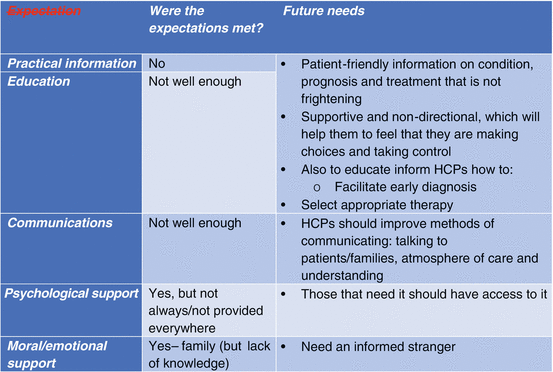

Fig. 1.5
Patient expectations around information, education and communication healthcare professional
Importantly, patients are looking for moral and emotional support to help develop coping mechanisms, including:
Encouragement to cope with diagnosis, treatment and its after effects
Emotional support, outside of family and friends. Patients are looking for someone else with the same disease
Psychological support
Treatment and Post-treatment Stages
The treatment stage brings a mixture of hope and fear for patients: hope for a positive outcome, but fear about the possible personal and social consequences of treatment. Different treatment options also brought about different levels of fear, with many patients initially being more fearful of chemotherapy than radiotherapy due to the associated hair loss. Patients also expressed the need to tailor information specifically to their situation; this information includes all aspects that need to be considered, along with different treatment options.
Although some patients felt hopeful throughout the diagnosis to treatment stage, post-treatment was different, and patients expressed the need for a lot of support services. Mainly, patients felt that the disfigurement and pain was extremely difficult to live with and looked to someone else with the disease to provide clarity and understanding. After treatment, a new sense of normality and comfort is important and patients are looking for a new way forward.
Taking the Next Step After ‘About Face’: The First Steps Towards ‘Make Sense’
As mentioned earlier, inspired by the results of the ‘About Face’ research series, the EHNS gathered experts from across Europe in 2012 to participate in a ‘Think Tank Meeting’ to tackle some of the issues uncovered.
The Think Tank group concluded that there was an urgent need for:
Broader multidisciplinary healthcare professional knowledge of the disease, and the skills to communicate effectively about it
Improved awareness of HNC symptoms across all stakeholder groups – HEALTHCARE PROFESSIONALS, patients and caregivers
An integrated network of patient advocacy groups (PAGs) and healthcare representatives
Greater emotional support for patients
Based on the recommendations proposed by the Think Tank group, the EHNS finalised a formal disease awareness campaign action plan, including a mission statement, ambassadors, taskforces and mandates, and the ‘Make Sense’ Campaign was born.
Make Sense Campaign
Based on the clear need to identify and treat HNC earlier to provide patients with the greatest likelihood of survival, the EHNS established and formally launched the Make Sense Campaign (MSC) in 2013, with Merck, previously Merck Serono, as a founding collaborator.
Make Sense Campaign Mission Statement
To raise awareness of HNC and to ultimately improve outcomes for patients with the disease
Based on the insights that there was a lack of clarity of the signs and symptoms of HNC and that successful interventions would require effective pan-European strategies, the Make Sense Campaign was created to:
- 1.
Raise awareness of HNC among the general public and healthcare providers across Europe to support earlier diagnosis and to ultimately improve patient outcomes
- 2.
Provide healthcare professionals and the general public across Europe with information about HNC
- 3.
Build partnerships and engage with policy-makers and patient advocacy groups to support patients with HNC
These aims would be addressed through the following key aspects of the campaign: driving awareness and education; encouraging earlier presentation, diagnosis and referral; and, improving care of patients.
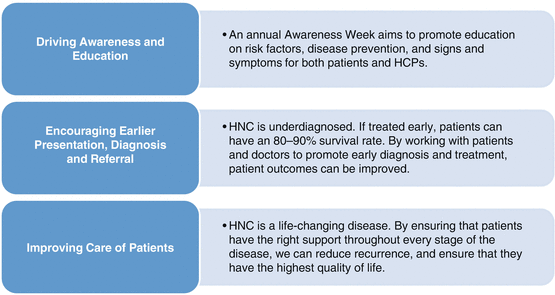

Laying the Foundations and Drawing on Expertise
With the goal of the Make Sense Campaign being a long-term, evolving initiative, the EHNS established an expert steering committee, Secretariat and four taskforces to research/address the key challenges in managing HNC.
Each taskforce was formed to address an identified unmet need – lack of awareness among the general public, lack of education for healthcare professionals about the signs and symptoms of HNC, lack of attention to patient care at a government level and lack of patient support resources.
Each taskforce agreed to conduct activities that would contribute to delivering on the Make Sense Campaign mission statement.
Awareness Raising Taskforce
Taskforce mandate: to increase awareness of HNC among the general public and the media.
The Awareness Raising taskforce aims to raise awareness of HNC among the general public and the media. It does this through a detailed programme of activities that aim to encourage a healthy lifestyle, earlier presentation, diagnosis and referral to healthcare professionals which culminates in an annual pan-European Awareness Week that is held in September.
Healthcare Professional (HCP) Education Taskforce
Taskforce mandate: to raise awareness of the signs and symptoms of HNC among general practitioners (GPs) and to encourage improved patient care.
The HCP Education taskforce aims to develop educational tools to reach primary care physicians, professional groups and other referring clinicians. These tools will aid the earlier presentation, diagnosis and referral of patients with HNC and ultimately achieve a universal understanding of the signs and symptoms healthcare professionals should look for when diagnosing HNC.
Partnership Building Taskforce
Taskforce mandate: to expand relationships with European and national–level members of parliament, as well as supporting the exchange of knowledge across patient groups.
The Partnership Building taskforce aims to work closely with European members of parliament to increase HNC on the European health agenda and to support groups for the exchange of knowledge among each other and other relevant European stakeholders. This will facilitate the ultimate aim of encouraging earlier presentation, diagnosis and referral of patients with HNC.
Stay updated, free articles. Join our Telegram channel

Full access? Get Clinical Tree



